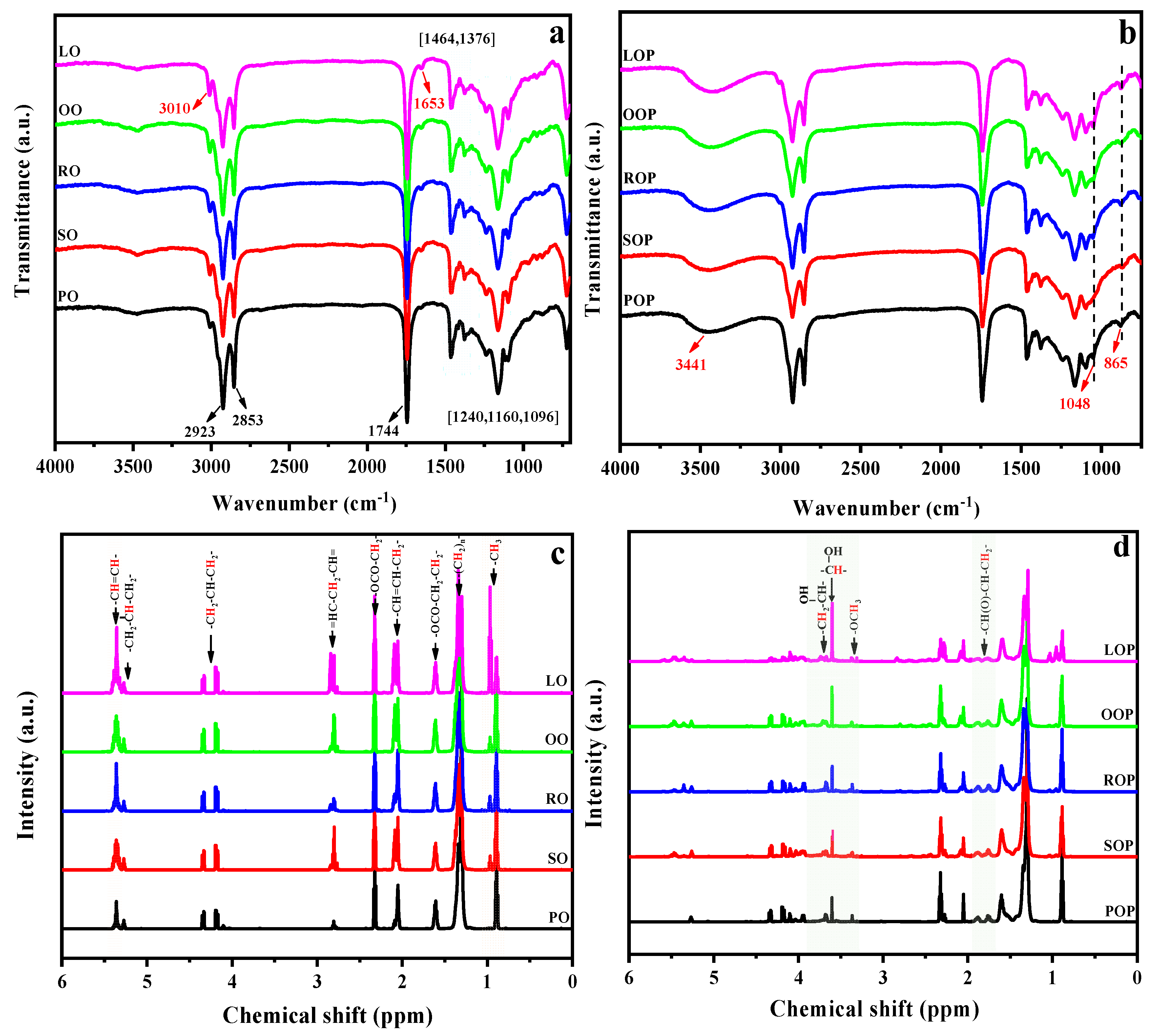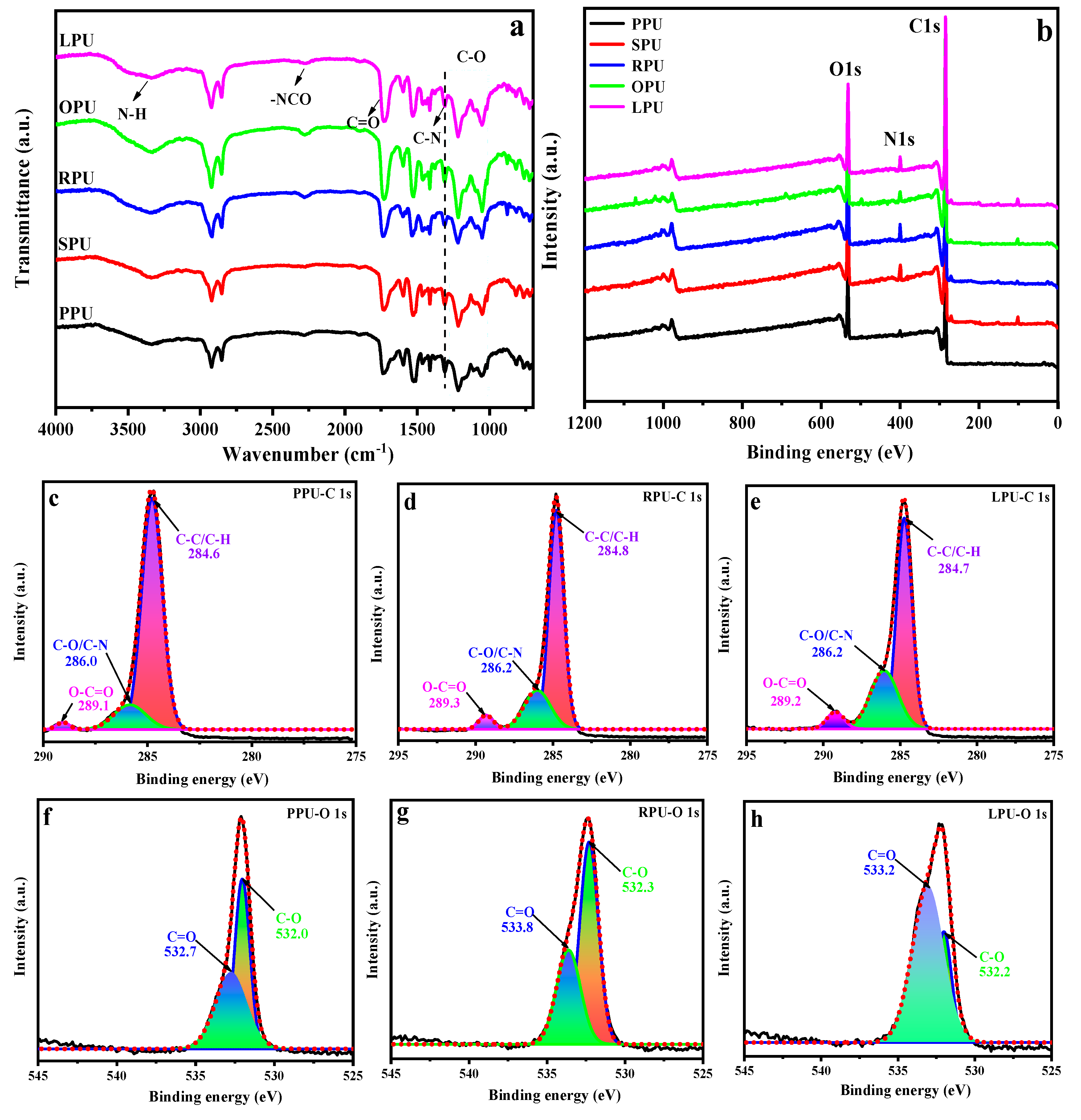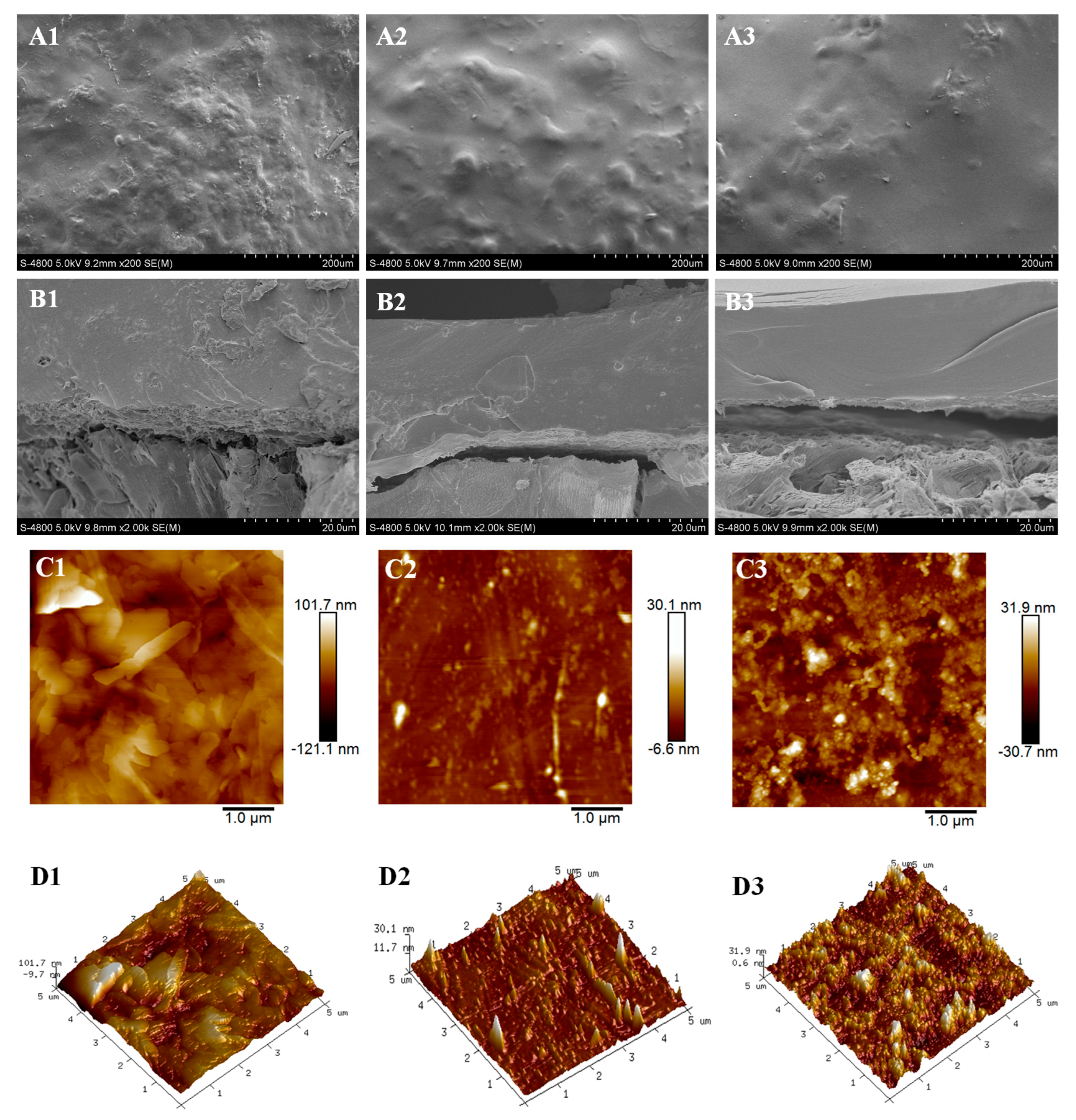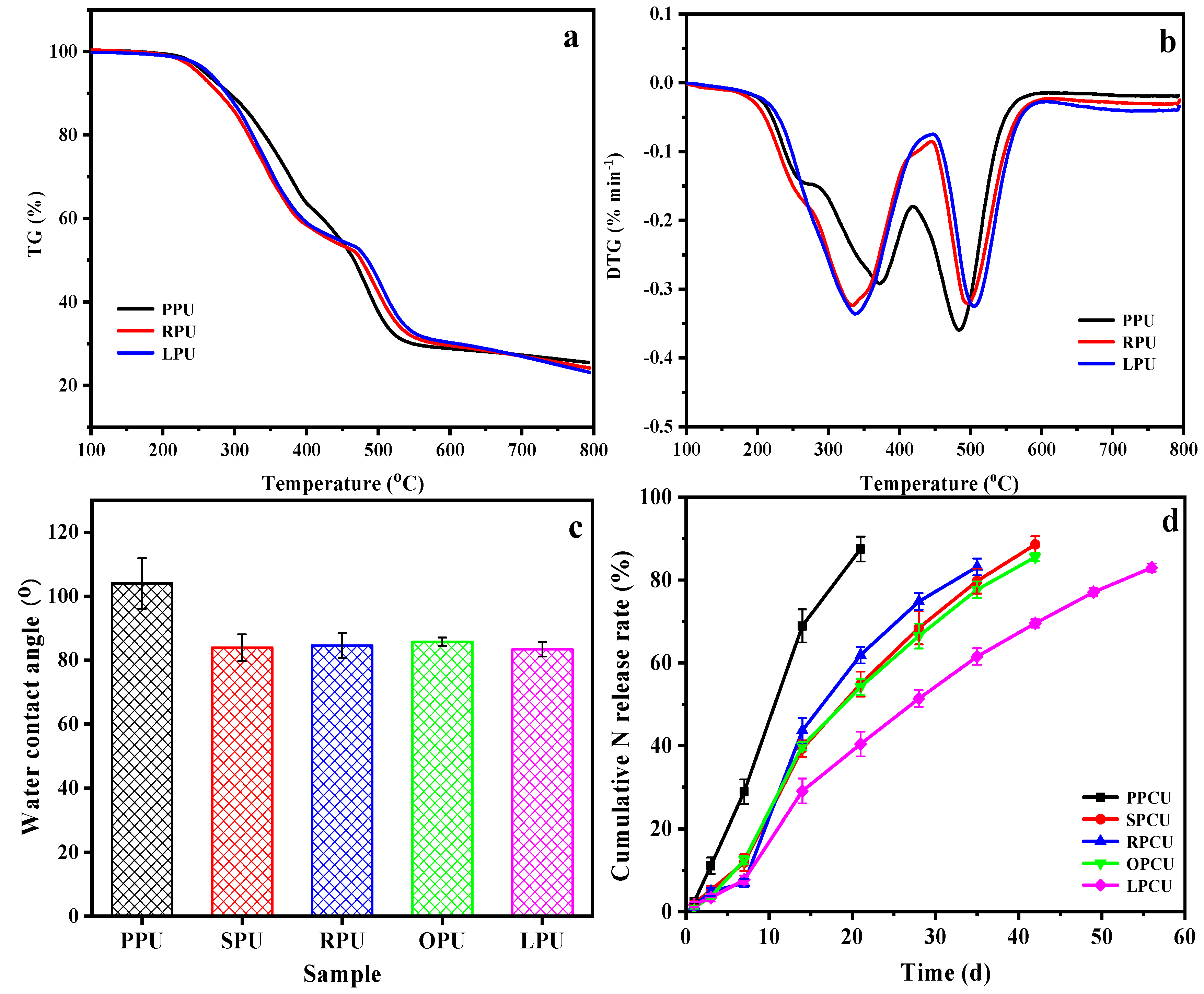Effect of Fatty Acids on Vegetable-Oil-Derived Sustainable Polyurethane Coatings for Controlled-Release Fertilizer
Abstract
:1. Introduction
2. Experimental Section
2.1. Materials
2.2. Synthesis of VOPs
2.3. Preparation of Coated Urea
2.4. Preparation of Films
2.5. Characterization
2.6. Nitrogen Release Behavior
2.7. Pot Experiment
3. Results and Discussion
3.1. Physicochemical Properties of VOPs
3.2. Chemical Structure of VOPs
3.3. Chemical Structure of Coatings
3.4. Morphology of Coatings
3.5. Macro-Properties of Coatings
3.6. Application Effect of Coated Urea
4. Conclusions
Supplementary Materials
Author Contributions
Funding
Institutional Review Board Statement
Informed Consent Statement
Data Availability Statement
Conflicts of Interest
References
- Daniel, A.I.; Fadaka, A.O.; Gokul, A.; Bakare, O.O.; Aina, O.; Fisher, S.; Burt, A.F.; Mavumengwana, V.; Keyster, M.; Klein, A. Biofertilizer: The future of food security and food safety. Microorganisms 2022, 10, 1220–1235. [Google Scholar] [CrossRef] [PubMed]
- Ma, X.C.; Li, F.F.; Chen, Y.W.; Chang, Y.Y.; Lian, X.F.; Li, Y.S.; Ye, L.; Yin, T.; Lu, X.P. Effects of fertilization approaches on plant development and fertilizer use of citrus. Plants 2022, 11, 2547–2558. [Google Scholar] [CrossRef] [PubMed]
- Jadon, P.; Selladurai, R.; Yadav, S.S.; Coumar, M.V.; Dotaniya, M.L.; Singh, A.K.; Bhadouriya, J.; Kundu, S. Volatilization and leaching losses of nitrogen from different coated urea fertilizers. J. Soil Sci. Plant Nut. 2018, 18, 1036–1047. [Google Scholar] [CrossRef]
- Zhang, M.; Yuan, Y.Z.; Jin, J.; Sun, J.Y.; Tian, X.H. Polyvinyl alcohol composite hydrogels/epoxidized natural rubber composites (CMCS/PVA/CS-ENR) with core-shell structure as biomass coating material for slow-release nitrogen fertilizer. Prog. Org. Coat. 2023, 183, 107744. [Google Scholar] [CrossRef]
- Shen, Y.M.; Wang, H.; Li, W.K.; Liu, Z.J.; Liu, Y.H.; Wei, H.L.; Li, J.J. Synthesis and characterization of double-network hydrogels based on sodium alginate and halloysite for slow release fertilizers. Int. J. Biol. Macromol. 2020, 164, 671–677. [Google Scholar] [CrossRef]
- Li, L.X.; Wang, M.; Wu, X.D.; Yi, W.P.; Xiao, Q. Bio-based polyurethane nanocomposite thin coatings from two comparable POSS with eight same vertex groups for controlled release urea. Sci. Rep. 2021, 11, 9917. [Google Scholar] [CrossRef]
- Azeem, B.; KuShaari, K.; Man, Z.B.; Basit, A.; Thanh, T.H. Review on materials & methods to produce controlled release coated urea fertilizer. J. Contr. Release 2014, 181, 11–21. [Google Scholar]
- Lawrencia, D.; Wong, S.K.; Low, D.Y.S.; Goh, B.H.; Goh, J.K.; Ruktanonchai, U.R.; Soottitantawat, A.; Lee, L.H.; Tang, S.Y. Controlled release fertilizers: A review on coating materials and mechanism of release. Plants 2021, 10, 238. [Google Scholar] [CrossRef]
- Fertahi, S.; Ilsouk, M.; Zeroual, Y.; Oukarroum, A.; Barakat, A. Recent trends inorganic coating based on biopolymers and biomass for controlled and slow release fertilizers. J. Contr. Release 2021, 330, 341–361. [Google Scholar] [CrossRef]
- Wang, S.P.; Li, X.; Ren, K.; Huang, R.; Lei, G.C.; Shen, L.J.; Zhan, Y.Y.; Jiang, L.L. Surface modification of pyrophyllite for optimizing properties of castor oil-based polyurethane composite and its application in controlled-release fertilizer. Arab. J. Chem. 2023, 16, 104400. [Google Scholar] [CrossRef]
- Liang, D.S.; Wang, Y.; Shi, H.B.; Luo, Z.L.; Quirino, R.L.; Lu, Q.M.; Zhang, C.Q. Controllable release fertilizer with low coating content enabled by superhydrophobic castor oil-based polyurethane nanocomposites prepared through a one-step synthetic strategy. Ind. Crop. Prod. 2022, 189, 115803. [Google Scholar] [CrossRef]
- Pang, M.H.; Dong, S.Q.; Zhao, J.G.; Li, H.Y.; Liu, D.S.; Li, L.X. Preparation of high bio-content polyurethane coatings from co-liquefaction of cellulosic biomass and starch for controlled release fertilizers. Coatings 2023, 13, 148. [Google Scholar] [CrossRef]
- Dong, H.P.; Tang, S.F.; Zhang, L.; Tong, Z.H.; Wu, Z.P.; Zhan, P.; Shao, L.S.; Qing, Y.; Liu, J. Wood-derived bio-coating materials incorporating hydrophobic lignin and hierarchically porous biochar for high-efficiency coating slow-release fertilizers. Int. J. Biol. Macromol. 2023, 242, 124769. [Google Scholar] [CrossRef] [PubMed]
- Tian, H.Y.; Li, Z.L.; Lu, P.F.; Wang, Y.; Jia, C.; Wang, H.L.; Liu, Z.G.; Zhang, M. Starch and castor oil mutually modified, cross-linked polyurethane for improving the controlled release of urea. Carbohyd. Polym. 2021, 251, 117060. [Google Scholar] [CrossRef] [PubMed]
- Li, L.X.; Geng, K.Q.; Liu, D.S.; Song, H.H.; Li, H.Y. Relationship between starch liquefaction behavior and properties of polymer coated urea from liquefied starch. Prog. Org. Coat. 2020, 147, 105759. [Google Scholar] [CrossRef]
- Paraskar, P.M.; Prabhudesai, M.S.; Hatkar, V.M.; Kulkarni, R.D. Vegetable oil based polyurethane coatings-a sustainable approach: A review. Prog. Org. Coat. 2021, 156, 106267. [Google Scholar] [CrossRef]
- Bortoletto-Santos, R.; Ribeiro, C.; Polito, W.L. Controlled release of nitrogen-source fertilizers by natural-oil-based poly (urethane) coatings: The kinetic aspects of urea release. Inc. J. Appl. Polym. Sci. 2016, 13, 43790. [Google Scholar] [CrossRef]
- Liang, D.S.; Zhang, Q.; Zhang, W.B.; Liu, L.X.; Liang, H.Y.; Quirino, R.L.; Chen, J.; Liu, M.H.; Lu, Q.M.; Zhang, C.Q. Tunable thermo-physical performance of castor oil-based polyurethanes with tailored release of coated fertilizers. J. Clean. Prod. 2019, 210, 1207–1215. [Google Scholar] [CrossRef]
- Ghasemlou, M.; Daver, F.; Ivanova, E.P.; Adhikari, B. Polyurethanes from seed oil-based polyols: A review of synthesis, mechanical and thermal properties. Ind. Crop. Prod. 2019, 142, 111841. [Google Scholar] [CrossRef]
- Feng, G.D.; Ma, Y.; Zhang, M.; Jia, P.Y.; Hu, L.H.; Liu, C.G.; Zhou, Y.H. Polyurethane-coated urea using fully vegetable oil-based polyols: Design, nutrient release and degradation. Prog. Org. Coat. 2019, 133, 267–275. [Google Scholar] [CrossRef]
- Acik, G.; Kamaci, M.; Altinkok, C.; Karabulut, H.F.; Tasdelen, M.A. Synthesis and properties of soybean oil-based biodegradable polyurethane films. Prog. Org. Coat. 2018, 123, 261–266. [Google Scholar] [CrossRef]
- Garrison, T.F.; Kessler, M.R.; Larock, R.C. Effects of unsaturation and different ring-opening methods on the properties of vegetable oil-based polyurethane coatings. Polymer 2014, 55, 1004–1011. [Google Scholar] [CrossRef]
- Watanabe, A.; Takebayashi, Y.; Ohtsubo, T.; Furukawa, M. Permeation of urea through various polyurethane membranes. Pest. Manag. Sci. 2009, 65, 1233–1240. [Google Scholar] [CrossRef]
- Liang, H.Y.; Feng, Y.C.; Lu, J.Y.; Liu, L.X.; Yang, Z.H.; Luo, Y.; Zhang, Y.; Zhang, C.Q. Bio-based cationic waterborne polyurethanes dispersions prepared from different vegetable oils. Ind. Crop. Prod. 2018, 122, 448–455. [Google Scholar] [CrossRef]
- Coman, A.E.; Peyrton, J.; Hubca, G.; Sarbu, A.R.; Gabor, A.; Nicolae, C.A.; Iordache, T.V.; Averous, L. Synthesis and characterization of renewable polyurethane foams using different biobased polyols from olive oil. Eur. Polym. J. 2021, 149, 110363. [Google Scholar] [CrossRef]
- Pang, M.H.; Dong, S.Q.; Zou, G.Y.; Zhao, J.G.; Li, H.Y.; Li, L.X. Study on reduction potential of curing agent in sustainable bio-based controlled release coatings. Polym. Test. 2023, 127, 108193. [Google Scholar] [CrossRef]
- Pillai, P.K.S.; Li, S.J.; Bouzidi, L.; Narine, S.S. Metathesized palm oil & novel polyol derivatives: Structure, chemical composition and physical properties. Ind. Crop. Prod. 2016, 84, 205–223. [Google Scholar]
- Zhang, J.M.; Hori, N.; Takemura, A. Optimization of agricultural wastes liquefaction process and preparing bio-based polyurethane foams by the obtained polyols. Ind. Crop. Prod. 2019, 138, 111455. [Google Scholar] [CrossRef]
- Borowicz, M.; Paciorek-Sadowska, J.; Isbrandt, M. Synthesis and application of new bio-polyols based on mustard oil for the production of selected polyurethane materials. Ind. Crop. Prod. 2020, 155, 112831. [Google Scholar] [CrossRef]
- Kong, X.H.; Liu, G.G.; Qi, H.; Curtis, J.M. Preparation and characterization of high-solid polyurethane coating systems based on vegetable oil derived polyols. Prog. Org. Coat. 2019, 76, 1151–1160. [Google Scholar] [CrossRef]
- Jayavani, S.; Sunanda, S.; Varghese, T.O.; Nayak, S.K. Synthesis and characterizations of sustainable polyester polyols from non-edible vegetable oils: Thermal and structural evaluation. J. Clean. Prod. 2017, 162, 795–805. [Google Scholar] [CrossRef]
- Yuan, S.N.; Cheng, L.; Tan, Z.X. Characteristics and preparation of oil-coated fertilizers: A review. J. Control. Release 2022, 345, 675–684. [Google Scholar] [CrossRef] [PubMed]
- Prociak, A.; Szczepkowski, L.; Ryszkowska, J.; Kurańska, M.; Auguścik, M.; Malewska, E.; Gloc, M.; Michałowski, S. Influence of chemical structure of petrochemical polyol on properties of bio-polyurethane foams. J. Polym. Environ. 2019, 27, 2360–2368. [Google Scholar] [CrossRef]
- Alagi, P.; Choi, Y.J.; Hong, S.C. Preparation of vegetable oil-based polyols with controlled hydroxyl functionalities for thermoplastic polyurethane. Eur. Polym. J. 2016, 78, 46–60. [Google Scholar] [CrossRef]
- Liao, Y.; Cao, B.; Liu, L.; Wu, X.D.; Guo, S.; Mi, C.H.; Li, K.W.; Wang, M. Structure and properties of bio-based polyurethane coatings for controlled-release fertilizer. J. Appl. Polym. Sci. 2021, 138, 5017. [Google Scholar] [CrossRef]
- Liu, P.; Lu, K.; Li, J.L.; Wu, X.W.; Qian, L.; Wang, M.J.; Gao, S.X. Effect of aging on adsorption behavior of polystyrene microplastics for pharmaceuticals: Adsorption mechanism and role of aging intermediates. J. Hazard. Mater. 2020, 384, 121193. [Google Scholar] [CrossRef]
- Jiao, L.L.; Xiao, H.H.; Wang, Q.S.; Sun, J.H. Thermal degradation characteristics of rigid polyurethane foam and the volatile products analysis with TG-FTIR-MS. Polym. Degrad. Stabil. 2013, 98, 2687–2696. [Google Scholar] [CrossRef]






| Variety | Saturated Fatty Acid | Mono-Unsaturated Fatty Acid | Poly-Unsaturated Fatty Acid | ||
|---|---|---|---|---|---|
| Palmitic Acid C16:0 | Stearic Acid C18:0 | Oleic Acid C18:1 | Linoleic Acid C18:2 | Linolenic Acid C18:3 | |
| Palm oil (PO) | 43.8 | 4.3 | 40.2 | 10.1 | 0.2 |
| Rapeseed oil (RO) | 4.1 | 1.8 | 56.4 | 24.3 | 10.1 |
| Olive oil (OO) | 13.7 | 2.5 | 69.8 | 10.0 | 0.4 |
| Soybean oil (SO) | 9.4 | 4.2 | 23.5 | 56.2 | 6.5 |
| Linseed oil (LO) | 5.8 | 3.7 | 18.9 | 16.1 | 57.4 |
| Parameter | POP | ROP | OOP | SOP | LOP |
|---|---|---|---|---|---|
| HV (mg KOH g−1) | 128 | 140 | 142 | 137 | 165 |
| AV (mg KOH g−1) | 6.12 | 6.28 | 5.18 | 7.11 | 6.61 |
| Mn (g mol−1) | 1119 | 1354 | 1485 | 1436 | 1279 |
| Mw (g mol−1) | 1193 | 1678 | 1793 | 1701 | 1727 |
| PDI | 1.07 | 1.21 | 1.18 | 1.18 | 1.33 |
| η25 (mPa·s) | 679 | 1450 | 2855 | 2016 | 1434 |
| f | 2.55 | 3.67 | 3.75 | 3.50 | 3.76 |
Disclaimer/Publisher’s Note: The statements, opinions and data contained in all publications are solely those of the individual author(s) and contributor(s) and not of MDPI and/or the editor(s). MDPI and/or the editor(s) disclaim responsibility for any injury to people or property resulting from any ideas, methods, instructions or products referred to in the content. |
© 2024 by the authors. Licensee MDPI, Basel, Switzerland. This article is an open access article distributed under the terms and conditions of the Creative Commons Attribution (CC BY) license (https://creativecommons.org/licenses/by/4.0/).
Share and Cite
Pang, M.; Liu, Z.; Li, H.; Liang, L.; Li, L. Effect of Fatty Acids on Vegetable-Oil-Derived Sustainable Polyurethane Coatings for Controlled-Release Fertilizer. Coatings 2024, 14, 1183. https://doi.org/10.3390/coatings14091183
Pang M, Liu Z, Li H, Liang L, Li L. Effect of Fatty Acids on Vegetable-Oil-Derived Sustainable Polyurethane Coatings for Controlled-Release Fertilizer. Coatings. 2024; 14(9):1183. https://doi.org/10.3390/coatings14091183
Chicago/Turabian StylePang, Minhui, Zirui Liu, Hongyan Li, Lina Liang, and Lixia Li. 2024. "Effect of Fatty Acids on Vegetable-Oil-Derived Sustainable Polyurethane Coatings for Controlled-Release Fertilizer" Coatings 14, no. 9: 1183. https://doi.org/10.3390/coatings14091183
APA StylePang, M., Liu, Z., Li, H., Liang, L., & Li, L. (2024). Effect of Fatty Acids on Vegetable-Oil-Derived Sustainable Polyurethane Coatings for Controlled-Release Fertilizer. Coatings, 14(9), 1183. https://doi.org/10.3390/coatings14091183





